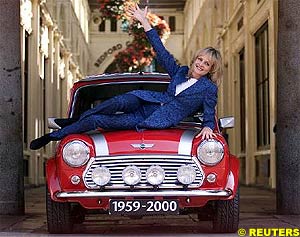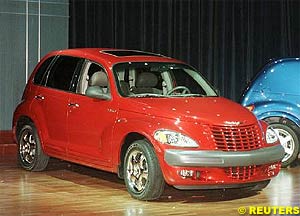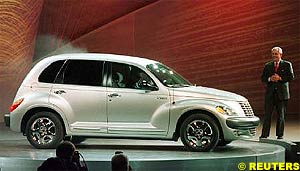

Automotive News and Reviews for the Petrolhead
Reuters Motoring Commentator
In this week's issue:
- BMW to Raise Mini Production
- Why the PT Cruiser Diesel is Hard to Resist
German luxury carmaker BMW has said it expects to increase the number of popular Mini hatchbacks it builds at its plant in Oxford, England by around 10 percent over the next few years.
"It is something that will be done gradually," BMW Chief Executive Helmut Panke told analysts in a conference call last week. "We are not looking at another facility to build Minis. Oxford is its home, and we have some good ideas to increase volume production there step by step... 180,000 a year would not be out of this world."
The company built around 160,000 Minis in Oxford last year with the factory running at its current full capacity and sold over 144,000, with the United Kingdom and the United States its top two markets. Investors had initially worried that BMW would struggle to make much profit on a product pitched squarely at the lower-margin small car market, but the company says it now makes money on every Mini it sells.
Chief Financial Officer Stefan Krause said the extent of demand for the more expensive and faster Cooper and Cooper S versions have also taken the company aback. They had initially expected the basic Mini One model to account for 60 percent to 70 percent of sales.
"It is exactly the opposite now. Sixty to 70 percent is what the Cooper and Cooper S models are contributing, and these are very high-margin vehicles," Krause said on the call, adding the company was selling more optional extras on the cars than expected.
BMW is tight-lipped about how profitable individual models are and about precisely when it will launch new variants, saying both are useful pieces of information for competitors, but it is widely expected to launch a Mini convertible in the near future.
It also introduced a diesel version of the car at the Geneva auto show earlier this month.
The BMW Group said it would strive to match last year's profits in 2003 as it grapples with high development costs for a range of new BMW brand cars due out this year, but it stopped short of giving a precise forecast, citing uncertainty over Iraq.
Do you remember the days, a long time ago, before Pop Idol, hand-held personal organisers and wheat beer? They were more basic times when choice was little more than the simple decision between BBC1 or ITV on a Saturday night; pork or beef on a Sunday; or Devon or Cornwall for your summer holiday.
And the family car was a Vauxhall Viva or a Ford Escort. Or maybe a Morris Marina. No matter which, it almost certainly came in a pale tint of a dowdy colour with horribly polished vinyl seats and a steering wheel the size of a dustbin lid. The lavish standard specification may well have included self-cancelling indicators, a manual choke and, wait for it, rear mud-flaps.
How times have changed. The contemporary equivalents to the Viva, Escort and Marina are still among the most popular cars in Britain (think Astra, Focus and Rover 45) but all boast levels of equipment and performance that would put a Viva-era Mercedes-Benz to shame.
In addition, there is a whole world of similarly capable five-door hatchbacks from the likes of VW, Renault, Toyota and Fiat. These days, even Spain makes splendid cars for the average Joe.
The age of the lifestyle vehicle is well into its stride and, quite simply, we've never had it so good. For similar money to the five-door hatch, there is now a much broader church. Our automotive lexicon has expanded to include phrases such as sportwagon, multi-purpose vehicle and sports-utility pick-up.
Cars like the Peugeot 307SW, Fiat Multipla and Renault Megane Scenic are all highly appealing alternatives to the standard five-door hatch.
The Chrysler PT Cruiser is another, and in terms of individuality, it's not particularly easy to pigeonhole in any conventional way, although it may well fall into that useful 'you either love it or you hate it' category. Hard facts prove that plenty of people love it with well over 300,000 examples sold since launch in 1999, but it is the latest model that looks likely to be difficult to resist for the family man.
Mercedes Designed Engine
Chrysler has just fitted its 2.2 CRD (common rail diesel) engine into the Cruiser Classic (the entry-level model), and it is a canny move. Firstly, the Mercedes-designed engine is an impressive unit.
Common rail technology improves fuel efficiency and lowers emissions through the precise control of its injection timing, combining the economy of diesel technology with the performance of petrol and this Daimler-Chrysler engine is a leading example of its ilk.
Secondly, last month, UK diesel registrations rose for the 29th consecutive month and now account for a quarter of the total market in this country, with industry predictions suggesting this is all set to rise to 30 percent by next year.
So a case of the right product in the right place at the right time then. And at the right price too. The CRD Classic is very competitive at 14,195 pounds on the road.
Impressive Fuel Economy
Anyone familiar with the PT Cruiser will feel instantly at home behind the wheel of the new model. In fact, once on the move, it is easy to forget you are driving a diesel as the CRD Classic's performance (and economy) lends credence to the whole concept of common rail technology. With 119bhp available, the car reaches 114mph and passes 62mph in a whisker over 12 seconds. Hardly in keeping with its pseudo hot-rod styling, but more than sufficient to keep family man happy.
What is class leading, however, is the level of available torque: 221lb ft. The real-world performance measur
But the family allowance won't suffer unduly as the Cruiser CRD also returns a thrifty 40.9mpg on the combined urban/extra-urban cycle.
In truth, neither economy nor performance is necessarily top-of-the-class in its own right but together with the caršs price, looks and specification, the PT Cruiser CRD is a compelling combination. The Classic model comes with a handsome level of standard equipment, including front and side airbags, ABS braking, air conditioning and electrically operated windows and mirrors all round. There is a decent audio system, generous overall interior space (rear leg room suffers a little) and just enough touches of retro styling to finish the whole thing off.
It really is true to say they don't make them like they used to. Thank God. If they did, instead of tucking our children up safely in the back of a PT Cruiser we'd still be giving them nightmares taking them to school in an Austin Maxi.
![]() BMW to Raise Mini Production
BMW to Raise Mini Production
 The success of the iconic little hatchback, a modern version of the British 1960s cult classic, has taken BMW executives by surprise and kept the firm's sales growth on the rise as its core BMW brand cars reach a low point in their product cycle.
The success of the iconic little hatchback, a modern version of the British 1960s cult classic, has taken BMW executives by surprise and kept the firm's sales growth on the rise as its core BMW brand cars reach a low point in their product cycle.
![]() Why the PT Cruiser Diesel is Hard to Resist
Why the PT Cruiser Diesel is Hard to Resist
 But spoiled as he may already be, there is more. Contemporary family man has been reconstructed and where sulky nights in with two cans of Harp were once the norm, sunny days out with the family in tow are the more modern way.
But spoiled as he may already be, there is more. Contemporary family man has been reconstructed and where sulky nights in with two cans of Harp were once the norm, sunny days out with the family in tow are the more modern way.
 es of low-speed, in-gear acceleration are impressive and the essential (and legal!) overtaking dash from 40 to 60mph takes just 5.4 seconds.
es of low-speed, in-gear acceleration are impressive and the essential (and legal!) overtaking dash from 40 to 60mph takes just 5.4 seconds.
© 1995-2005 Kaizar.Com, Inc. . This service is provided under the Atlas F1 terms and conditions.
|
Volume 9, Issue 13
Malaysian GP Review
2003 Malaysian GP Review
Technical Review: Malaysian GP
Articles
The Changing of the Guard
The Buck Stops Where?
Ann Bradshaw: View from the Paddock
Uncorked
Stats Center
Qualifying Differentials
SuperStats
Charts Center
Columns
Season Strokes
On the Road
Elsewhere in Racing
The Weekly Grapevine
> Homepage |